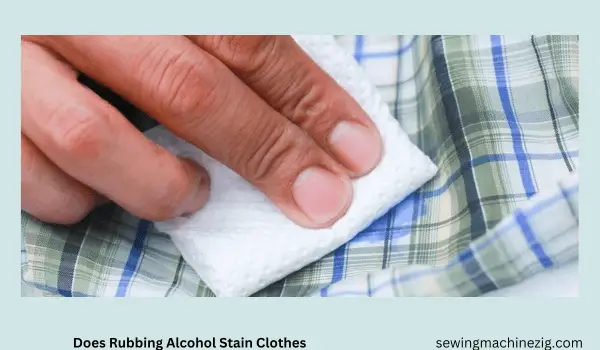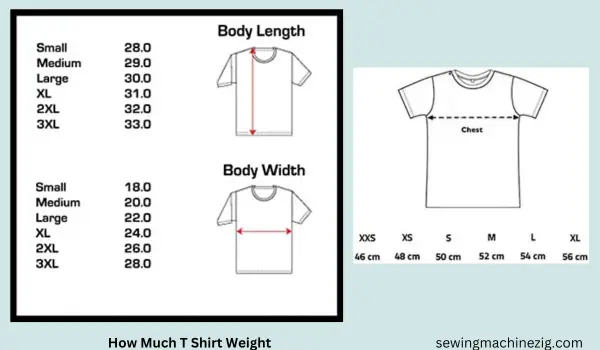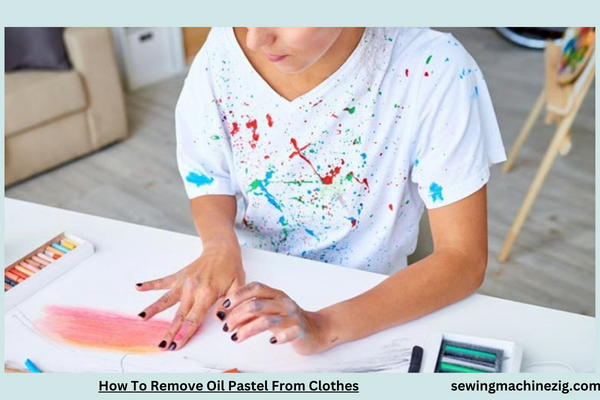
Ever found yourself in the colorful chaos of an oil pastel mishap on your cherished garments? The struggle is undeniably vivid, and we empathize with the exasperation it brings! Whether it’s the aftermath of an artsy endeavor or an accidental encounter with expressive hues, extracting oil pastel stains from clothes can be a daunting feat.
Fret not! In this guide, how to remove oil pastel from clothes we’ll demystify the art of banishing oil pastel blemishes, providing you with simple yet effective solutions to salvage your wardrobe. Say goodbye to stained attire as we embark on a colorful journey of stain removal mastery!
How To Remove Oil Pastel From Clothes Detailed Answer

Tackling the vibrant aftermath of an oil pastel mishap on your clothes may seem like an artistic challenge, but fear not! In this comprehensive guide,“how to remove oil pastel from clothes” We’ll walk you through a simple and detailed process to rescue your garments from the colorful consequences of your creative endeavors.
The Art of Oil Pastel Stain Removal:
Step 1: Swift Action
Timing is crucial when dealing with oil pastel stains. Act promptly to prevent the colors from setting into the fabric. The sooner you address the stain, the higher the chances of successful removal.
Step 2: Scrape Off Excess
Start by gently scraping off any excess oil pastel using a spoon, dull knife, or the edge of a credit card. Be careful not to spread the stain further by rubbing vigorously.
Step 3: Blot with Paper Towels
Place a few layers of paper towels or a clean cloth under the stained area. Blot the stain from the top with another set of paper towels. This helps absorb as much of the oil pastel as possible.
Step 4: Pre-treat with Dish Soap
Apply a small amount of dish soap directly to the stain. Gently rub the fabric together to work the soap into the fibers. Dish soap is effective in breaking down the oily components of oil pastels.
Step 5: Rinse with Cold Water
Hold the stained fabric under cold running water, ensuring the water flows from the backside of the stain. Cold water helps flush out the oil pastel without setting it into the fabric.
Step 6: Launder as Usual
After pre-treating the stain, launder the garment as you normally would. Check the care label for specific washing instructions. Use a high-quality laundry detergent to ensure effective stain removal.
Step 7: Inspect Before Drying
Before tossing the garment into the dryer, check to ensure the oil pastel stain is completely gone. Heat from the dryer can set any remaining residue, making it more challenging to remove.
Step 8: Air Dry
Once you’re confident the stain is gone, air-dry the garment. This allows you to verify that the stain has been successfully removed before exposing it to the heat of a dryer.
Step 9: Check and Repeat if Necessary
Inspect the garment thoroughly after air-drying. If any traces of the oil pastel stain remain, repeat the pre-treatment steps before drying.
Additional Tips for Oil Pastel Stain Removal:
- Freeze and Scrape Technique:
- For stubborn stains, place the garment in the freezer for a couple of hours.
- Once the oil pastel hardens, carefully scrape off the excess with a spoon or a dull knife.
- Use Hairspray:
- Spray a small amount of hairspray directly onto the stain.
- Blot the area with a clean cloth to lift the dissolved oil pastel.
- Apply Rubbing Alcohol:
- Dab a small amount of rubbing alcohol on the stain.
- Blot the area with a clean cloth to lift the oil pastel. Test in an inconspicuous area first.
- Use Baby Wipes:
- Gently blot the stain with a baby wipe.
- The mild cleaning agents in baby wipes can help break down the oil pastel.
- Cornstarch or Talcum Powder Absorption:
- Sprinkle cornstarch or talcum powder on the stain after blotting off excess oil pastel.
- Allow it to sit for a while to absorb the remaining oily residue.
- Try White Vinegar:
- Mix equal parts white vinegar and water.
- Dab the mixture onto the stain, allowing it to sit for a few minutes before rinsing.
- Heat Transfer Method:
- Place a paper towel over the stained area.
- Iron the back of the garment, allowing the heat to transfer the oil pastel onto the paper towel.
- Professional Cleaning:
- If the garment is delicate or the stain persists, consider professional dry cleaning.
- Avoid Hot Water and Heat:
- Throughout the stain removal process, avoid hot water and high heat settings to prevent setting the stain.
Summary:
Rescuing your clothes from the vibrant marks of oil pastels is a creative endeavor in itself. Swift action, blotting, pre-treating with dish soap, and careful laundering are the foundational steps.
Additional tips like the freeze and scrape technique, using hairspray or rubbing alcohol, baby wipes, cornstarch, white vinegar, and the heat transfer method offer unique approaches to oil pastel stain removal.
Remember to avoid heat, test in inconspicuous areas, and consider professional cleaning for delicate garments. With this comprehensive guide, you’ll be equipped to turn your stained clothes into a blank canvas once again, ready for new artistic adventures. “how to remove oil pastel from clothes“
Do Soft Pastels Stain Clothes?
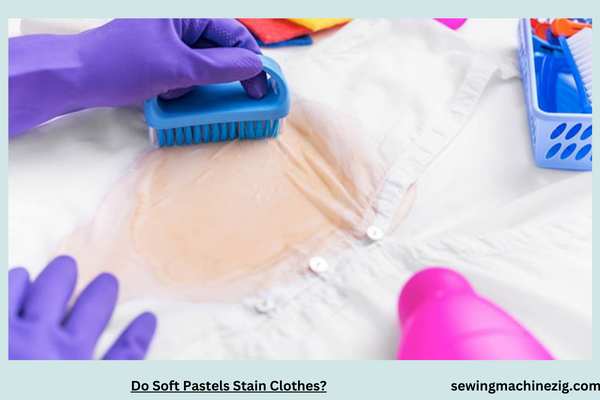
Diving into the world of soft pastels and creating beautiful art can be a joy, but what happens when those vibrant hues end up on your clothes?
Fear not! In this comprehensive guide, we’ll explore whether soft pastels stain clothes and provide you with a simple and detailed process to tackle any colorful mishaps. Let’s transform the potential stress of stains into a canvas of knowledge, making your artistic journey a seamless blend of creativity and cleanliness.
Understanding Soft Pastels:
Before we delve into the stain removal process, it’s essential to understand soft pastels. Soft pastels are composed of pigment, chalk, and a binder. The delicate and powdery nature of soft pastels makes them prone to smudging and transferring onto various surfaces, including clothing.
Do Soft Pastels Stain Clothes?
Yes, soft pastels can indeed stain clothes. The powdery composition of these art supplies makes them susceptible to leaving marks on fabric. However, the good news is that with the right approach, you can effectively remove these stains and salvage your garments.
Stain Removal Process:
Step 1: Act Quickly
Timing is key when dealing with soft pastel stains. The sooner you address the issue, the better your chances of successful removal. Begin by gently shaking or brushing off any loose pastel particles from the fabric.
Step 2: Blot, Don’t Rub
Avoid rubbing the stained area, as this may cause the pastel pigments to penetrate the fabric further. Instead, use a clean cloth or paper towel to gently blot the stain. This helps to lift the loose pigments without spreading them.
Step 3: Pre-treat with Cornstarch or Talcum Powder
To absorb excess pigment and oil from the soft pastels, sprinkle cornstarch or talcum powder onto the stain. Allow it to sit for at least 15 minutes, letting the powder work its magic in absorbing the pastel pigments.
Step 4: Brush Away Residue
After the powder has had time to absorb the pastel pigments, use a soft brush (like a clean makeup brush) to gently brush away the residue. This helps to remove the bulk of the pigments without causing further damage to the fabric.
Step 5: Pre-treat with Dish Soap
Apply a small amount of dish soap directly to the stained area. Gently rub the fabric together to work the soap into the fibers. Dish soap is effective in breaking down the oily components of soft pastels.
Step 6: Rinse with Cold Water
Hold the stained fabric under cold running water, allowing the water to flow from the back of the stain. Cold water helps flush out the pastel pigments without setting them into the fabric.
Step 7: Launder as Usual
After pre-treating the stain, launder the garment as you normally would. Check the care label for specific washing instructions. Use a high-quality laundry detergent to ensure effective stain removal.
Step 8: Inspect Before Drying
Before tossing the garment into the dryer, check to ensure the soft pastel stain is completely gone. Heat from the dryer can set any remaining residue, making it more challenging to remove.
Step 9: Air Dry
Once you’re confident the stain is gone, air-dry the garment. This allows you to verify that the stain has been successfully removed before exposing it to the heat of a dryer.
Step 10: Check and Repeat if Necessary
Inspect the garment thoroughly after air-drying. If any traces of the soft pastel stain remain, repeat the pre-treatment steps before drying.
Additional Tips for Soft Pastel Stain Removal:
- Use Hairspray:
- Spray a small amount of hairspray directly onto the stain.
- Blot the area with a clean cloth to lift the dissolved pastel pigments.
- Baby Wipes to the Rescue:
- Gently blot the stain with a baby wipe.
- The mild cleaning agents in baby wipes can help break down the pastel pigments.
- Try White Vinegar:
- Mix equal parts white vinegar and water.
- Dab the mixture onto the stain, allowing it to sit for a few minutes before rinsing.
- Avoid Heat:
- Throughout the stain removal process, avoid hot water and high heat settings to prevent setting the stain.
- Professional Cleaning:
- If the garment is delicate or the stain persists, consider professional dry cleaning.
Summary:
Soft pastels, with their powdery and vibrant nature, can indeed stain clothes, but with the right approach, you can bid farewell to those artistic blemishes. Act swiftly, blot, pre-treat with cornstarch, brush away residue, use dish soap, rinse with cold water, and follow the laundering process.
Additional tips on “how to remove oil pastel from clothes” like hairspray, baby wipes, white vinegar, and avoiding heat offer unique approaches to soft pastel stain removal. Remember to inspect before drying, air-dry, and repeat if necessary.
With this comprehensive guide, you’ll be equipped to embrace the artistic side of life without fearing the aftermath of your favorite clothes. Let your creativity flow, and don’t let a little pastel stain dull your artistic spirit!
Is It Dangerous To Leave Oil Pastels On Clothes?
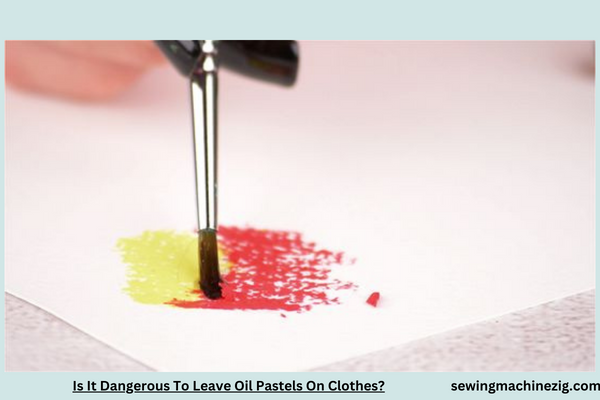
Delving into the world of art with oil pastels can be a delightful and colorful experience, but what happens when those vibrant hues end up on your clothes? The question arises: Is it dangerous to leave oil pastels on clothes?
In this comprehensive guide, we’ll explore the potential risks, delve into the composition of oil pastels, and provide a simple and detailed process to ensure your garments remain unscathed. Let’s transform the uncertainty of oil pastel stains into a canvas of knowledge, making your artistic journey seamlessly colorful without compromising your wardrobe.
Understanding Oil Pastels:
Before we address the safety concerns, let’s take a moment to understand what oil pastels are made of. Oil pastels consist of pigment, a non-drying oil (usually mineral oil or a similar substance), and a non-acidic wax binder. The combination of these ingredients gives oil pastels their creamy texture and vibrant color.
Is It Dangerous to Leave Oil Pastels on Clothes?
Leaving oil pastels on clothes is not inherently dangerous, as oil pastels are generally non-toxic. However, there are considerations to keep in mind. The non-drying nature of the oil in the pastels means that they may remain on the fabric if not properly addressed. Over time, this can lead to stains and affect the appearance of your clothing.
The Stain Removal Process:
If you find yourself with oil pastel marks on your clothes, here’s a simple and detailed process to ensure effective stain removal:
Step 1: Act Quickly
Timing is crucial when dealing with oil pastel stains. Act promptly to prevent the oil pastels from setting into the fabric. Gently shake or brush off any loose pastel particles from the fabric.
Step 2: Blot, Don’t Rub
Avoid rubbing the stained area, as this may cause the oil pastel pigments to penetrate the fabric further. Instead, use a clean cloth or paper towel to gently blot the stain. This helps lift the loose pigments without spreading them.
Step 3: Pre-treat with Cornstarch or Talcum Powder
To absorb excess oil and pigment from the oil pastels, sprinkle cornstarch or talcum powder onto the stain. Allow it to sit for at least 15 minutes, letting the powder absorb the oil pastel residue.
Step 4: Brush Away Residue
After the powder has had time to absorb the oil pastel pigments, use a soft brush (such as a clean makeup brush) to gently brush away the residue. This step helps remove the bulk of the pigments without causing damage to the fabric.
Step 5: Pre-treat with Dish Soap
Apply a small amount of dish soap directly to the stained area. Gently rub the fabric together to work the soap into the fibers. Dish soap is effective in breaking down the oily components of oil pastels.
Step 6: Rinse with Cold Water
Hold the stained fabric under cold running water, allowing the water to flow from the back of the stain. Cold water helps flush out the oil pastel pigments without setting them into the fabric.
Step 7: Launder as Usual
After pre-treating the stain, launder the garment as you normally would. Check the care label for specific washing instructions. Use a high-quality laundry detergent to ensure effective stain removal.
Step 8: Inspect Before Drying
Before tossing the garment into the dryer, check to ensure the oil pastel stain is completely gone. Heat from the dryer can set any remaining residue, making it more challenging to remove.
Step 9: Air Dry
Once you’re confident the stain is gone, air-dry the garment. This allows you to verify that the stain has been successfully removed before exposing it to the heat of a dryer.
Step 10: Check and Repeat if Necessary
Inspect the garment thoroughly after air-drying. If any traces of the oil pastel stain remain, repeat the pre-treatment steps before drying.
Additional Tips for Oil Pastel Stain Removal:
- Use Hairspray:
- Spray a small amount of hairspray directly onto the stain.
- Blot the area with a clean cloth to lift the dissolved oil pastel pigments.
- Baby Wipes to the Rescue:
- Gently blot the stain with a baby wipe.
- The mild cleaning agents in baby wipes can help break down the oil pastel pigments.
- Try White Vinegar:
- Mix equal parts white vinegar and water.
- Dab the mixture onto the stain, allowing it to sit for a few minutes before rinsing.
- Avoid Heat:
- Throughout the stain removal process, avoid hot water and high heat settings to prevent the stain.
- Professional Cleaning:
- If the garment is delicate or the stain persists, consider professional dry cleaning.
Summary:
Leaving oil pastels on clothes may not be dangerous, but it can lead to stains and affect the appearance of your garments over time. The stain removal process involves acting quickly, blotting, pre-treating with cornstarch, using dish soap, and following a careful laundering process.
Additional tips like using hairspray, baby wipes, white vinegar, and avoiding heat offer unique approaches to oil pastel stain removal. Remember to inspect before drying, air-dry, and repeat if necessary. With this comprehensive guide, you can embrace your artistic endeavors without worrying about the impact on your wardrobe, turning potential stains into a canvas of colorful knowledge.
Conclusion
As we conclude our exploration into the realm of stain removal, the triumph over oil pastel blemishes on clothing emerges as an art form in itself. Armed with a strategic combination of dish soap, patience, and gentle techniques, one can transform stained garments into a pristine canvas once more.
The key lies in swift action, choosing the right tools, and embracing the process with artistic determination. Bid farewell to oil pastel stains, and let your clothing showcase a masterpiece of stain-free success. “how to remove oil pastel from clothes“
FAQs: How to Remove Oil Pastel from Clothes
Q1: What’s the initial step when dealing with an oil pastel stain on clothing?
A1: Begin by scraping off excess oil pastel gently with a spoon or blunt knife to prevent further spreading. “how to remove oil pastel from clothes“
Q2: Can any type of dish soap be used for pre-treating an oil pastel stain, or are certain formulations better?
A2: Opt for a mild, clear dish soap. Highly fragranced or colored options may contain additives that could affect the fabric. “how to remove oil pastel from clothes“
Q3: Does the fabric type play a role in the success of removing oil pastel stains?
A3: Yes, it does. Different fabrics may require tailored approaches. For delicate fabrics, consider professional cleaning.”how to remove oil pastel from clothes“
Q4: Is hot water suitable for washing clothes with oil pastel stains, or is cold water preferable?
A4: Cold water is recommended for oil pastel stains. Hot water can cause the oil to set into the fabric. “how to remove oil pastel from clothes“
Q5: Can oil pastel stains be removed from colored clothing without fading or damaging the color?
A5: Test any stain removal method on a small, inconspicuous area first to ensure it won’t cause fading or damage. “how to remove oil pastel from clothes“
Q6: Are there specific fabrics or materials where removing oil pastel stains is particularly challenging?
A6: Fabrics with intricate weaves or special finishes may pose challenges. Seek professional cleaning for stubborn cases. “how to remove oil pastel from clothes“


